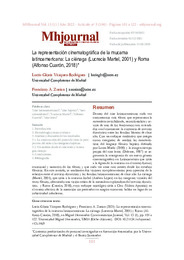Por favor, use este identificador para citar o enlazar este ítem:
https://hdl.handle.net/11000/26399Registro completo de metadatos
| Campo DC | Valor | Lengua/Idioma |
|---|---|---|
| dc.contributor.author | Vázquez Rodríguez, Lucía Gloria | - |
| dc.contributor.author | Zurian, Francisco A. | - |
| dc.date.accessioned | 2022-03-28T11:23:50Z | - |
| dc.date.available | 2022-03-28T11:23:50Z | - |
| dc.date.created | 2022-01-31 | - |
| dc.identifier.citation | Vol. 13 (2022) | es_ES |
| dc.identifier.issn | 1989-8681 | - |
| dc.identifier.uri | http://hdl.handle.net/11000/26399 | - |
| dc.description.abstract | Dentro del cine latinoamericano cada vez encontramos más filmes que representan la naturaleza invisibilizada, neocolonialista y se-xista de uno de los fenómenos más extendi-dos en el continente: la existencia de servicio doméstico entre las familias blancas de clase alta. Con un enfoque cualitativo que integra como categorías de análisis las caracterís-ticas del lenguaje fílmico háptico definido por Laura Marks (2000) y la imagen-tiempo propia del cine lento (Deleuze, 1987) se ar-gumenta la emergencia de un nuevo género cinematográfico en Latinoamérica que sitúa a la figura de la mucama en el centro formal, emocional y narrativo de los filmes, y que cada vez atrae más interés desde los estudios fílmicos. En este sentido, se analizarán dos visiones complementarias pero opuestas de la relación entre el servicio doméstico y las familias latinoamericanas de clase alta: La ciénaga (Martel, 2001), que sitúa a la mucama Isabel (Andrea López) en los márgenes visuales del texto fílmico, ofreciendo una visión crítica de la naturaleza explotadora del servicio domés-tico; y Roma (Cuarón, 2018), cuyo enfoque nostálgico sitúa a Cleo (Yalitza Aparicio) en el centro afectivo de la narración sin pretender en ningún momento hablar en lugar de su subjetividad subalterna | es_ES |
| dc.description.abstract | Recent Latin American cinema is increas-ingly interested in the representation of the invisibilized, neocolonialist and sexist nature of the existence of domestic ser-vantss amongst upper-class white families, one of the most widespread phenomena in the continent. Implementing a qualita-tive approach that integrates as categories for the analysis the traits of haptic filmic language (Marks, 2000) and the time-im-age typical of slow cinema (Deleuze, 1987), we argue the emergence of a new film genre in Latin America that places the figure of the maid in the formal, emo-tional and narrative center of the films, and that increasingly attracts more interest from film studies. In this regard, we analyze two complementing yet opposing visions of the relationship between domestic service and upper-class Latin American families: La ciénaga (Martel, 2001), which places the maid Isabel (Andrea López) on the visual margins of the filmic text, offering a critical view of the exploitative nature of domestic service; and Roma (Cuarón, 2018), whose nostalgic ap-proach locates Cleo (Yalitza Aparicio) at the center of the narrative while carefully avoiding any pretense to speak in place of her subaltern subjectivity | es_ES |
| dc.format | application/pdf | es_ES |
| dc.format.extent | 22 | es_ES |
| dc.language.iso | spa | es_ES |
| dc.publisher | Universidad Miguel Hernández de Elche | es_ES |
| dc.rights | info:eu-repo/semantics/openAccess | es_ES |
| dc.rights | Attribution-NonCommercial-NoDerivatives 4.0 Internacional | * |
| dc.rights.uri | http://creativecommons.org/licenses/by-nc-nd/4.0/ | * |
| dc.subject | cine latinoamericano | es_ES |
| dc.subject | cine háptico | es_ES |
| dc.subject | neo-colonialismo | es_ES |
| dc.subject | Lucrecia Martel | es_ES |
| dc.subject | Alfonso Cuarón | es_ES |
| dc.subject | cine lento | es_ES |
| dc.subject.other | CDU::3 - Ciencias sociales | es_ES |
| dc.title | La representación cinematográfica de la mucama latinoamericana: La ciénaga (Lucrecia Martel, 2001) y Roma (Alfonso Cuarón, 2018) | es_ES |
| dc.title.alternative | Cinematic representations of Latin American domestic workers: La ciénaga (Lucrecia Martel, 2001) and Roma (Alfonso Cuarón, 2018) | es_ES |
| dc.type | info:eu-repo/semantics/article | es_ES |
| dc.identifier.doi | 10.21134/mhjournal.v13i.1469 | - |
| dc.relation.publisherversion | https://doi.org/10.21134/mhjournal.v13i.1469 | - |

Ver/Abrir:
1469-Texto del artículo-6823-1-10-20220131.pdf
1,18 MB
Adobe PDF
Compartir:
 La licencia se describe como: Atribución-NonComercial-NoDerivada 4.0 Internacional.
La licencia se describe como: Atribución-NonComercial-NoDerivada 4.0 Internacional.
.png)